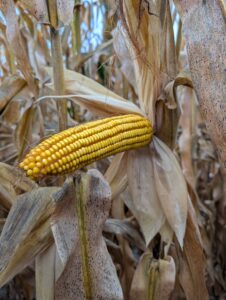Illinois Crop Update – September 26, 2025
Reagen Tibbs– Commercial Agriculture Educator
Logan County
Soil Condition: Moderately Dry (soil is dry, plants may be browning or stressed, water bodies are low)
Rains over the last week have been welcome but have not provided the much-needed relief from drought conditions. If anything, the rain has slowed the harvest progress for many across Logan County. While on the outside rows, some fields appear ready to harvest, there are still many green plants deep inside the fields. Soybeans have been most affected by the lack of rain, with very few green leaves left on the plants.
Talon Becker – Commercial Agriculture Specialist
Ford County
Soil Condition: Mildly Dry (soil is drier than normal, plant growth may have slowed)
This past week brought some relief from the dry weather in east central IL, but rainfall totals in the region were generally <1″ and variable, with some areas receiving <0.1″ (IL State Water Survey – WARM Program; Midwest Regional Climate Center – Ag Climate Dashboard). And unfortunately, it comes too late for most of the corn and soybean crop to benefit. That said, during my survey in Ford County this week, I did see several pastures, double-crop soybean fields, a few alfalfa fields, and a handful of fields planted to annual forage mixes that will get some benefit from the precipitation as the growing season winds down.
Harvested corn and soybean acres in Ford County were still low, perhaps 10%, with the recent rain stalling progress for a few days. And at the time of my survey, I would say more soybean fields have been cleared than corn fields, but there were still a number of corn fields fully harvested or at least “opened up”. All corn fields surveyed were at R6 “black layer”, but about half were still showing some green in the upper canopy. Tar spot is also easy to find at this point in the season, with heavier pressure in the northern part of the county. However, it appears to have come in late enough to not have greatly affected yields, with relatively full ears on most plants checked during the survey. Of the full-season soybean fields surveyed, most were at R8 (full maturity), while the couple double-crop soybean fields I stopped at seemed to be stuck in R5 (beginning seed), struggling to fill pods.

Dane Hunter – Commercial Agriculture Specialist
Marion County
Soil Condition: Near Normal
Last weekend we accumulated a little over 3″ of rainfall over the course of several storms. Harvest had just kicked off last week only to come to a halt while the surface soil dries back out. Unfortunately, this rain came a few weeks too late to help most of our crop. Most of the corn and early beans are already either dead or well into senescence and will not benefit. I pulled a couple of soybean plants that will be ready to harvest in a week or so and while they had a decent number of pods, quite a few of them were completely flat. There are some double crop and late planted beans that are just starting to tinge yellow, they might benefit from the late moisture. Time will tell.





